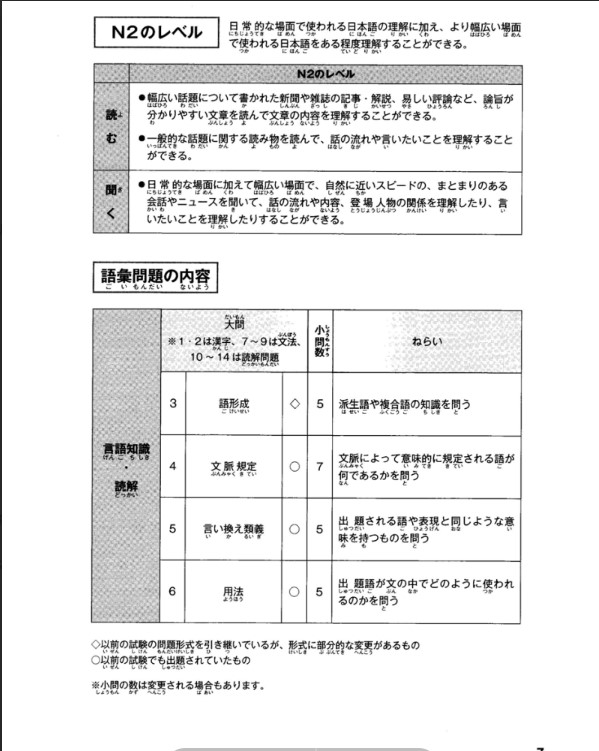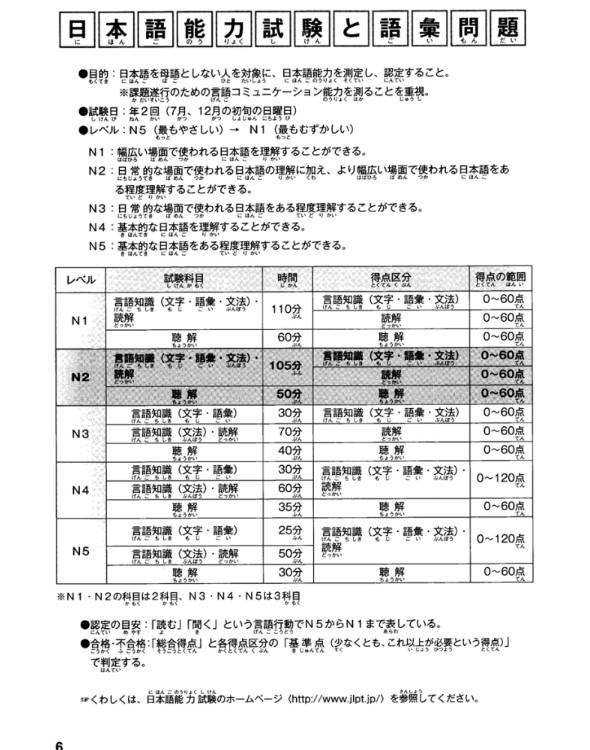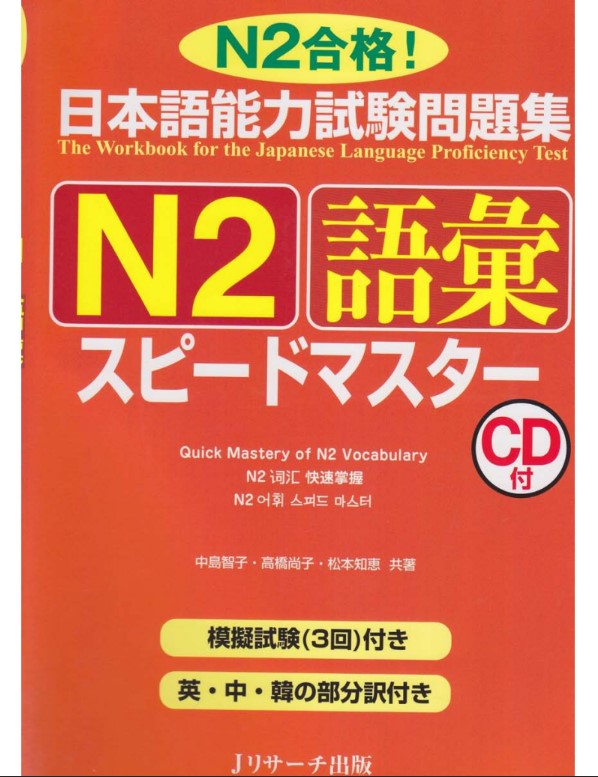


Hình 1:
もくじ
Contents / 目次 / 목차
はじめに Foreword/Lời tựa ………………………………………………………………………………………….. 3
もくじ Contents / 目次 / 목차 ………………………………………………………………………………………… 4
日本語能力試験と語彙問題 Japanese Language Proficiency Test and vocabulary comprehension exercises / 日语能力考试和词汇问题 / 일본어 능력 시험과 어휘 문제 …………………………………………………………… 6
この本の使い方 How to use this book / 此书的使用方法 / 이 책의 사용법 …………………………………………………………………………………………………………… 8
ウォーミングアップ―復習ドリル 第1回~第5回
Warming up: Drills for revision – Practice exercises, Lesson 1 to Lesson 5 / 热身练习―复习练习 第一回~第五回 / 워밍업―복습 드릴 제1회~제5회 …………………………………………………………………………………………………………………………………………………. 10
PART 1 新しい言葉を覚えよう
Memorizing new words / 记记新的单词 / 새로운 단어를 외우자
あたら
ことば
- 時間 Time / 时间 / 시간 ………………………………………………………………………………………………………………………………………. 16
- 家 Home / 家 / 집 ………………………………………………………………………………………………………………………………………………… 18
- お金 Money / 金銭 / 돈 ………………………………………………………………………………………………………………………………………. 20
- 数 Numbers & quantity / 数・量 / 수・량 ………………………………………………………………………………………………………………………. 22
- 国・社会 Nation & society / 国・社会 / 국가· 사회 …………………………………………………………………………………………………………….. 24
- 産業・技術 Industry & technology / 産業・技術 / 산업· 기술 ……………………………………………………………………………………………………. 26
- 自然 Nature / 自然 / 자연 ………………………………………………………………………………………………………………………………………. 28
- 体・健康 Body & health / 身体・健康 / 몸· 건강 ………………………………………………………………………………………………………….. 30
●第1回 Practice exercises / 实践练习 / 실천 연습 ……………………………………………………………………………………………………………………. 32 - 交通 Traffic / 交通 / 교통 ………………………………………………………………………………………………………………………………………. 34
- 位置・方向 Location, direction / 位置・方向 / 위치· 방향 ……………………………………………………………………………………………………….. 36
- 趣味・活動 Hobby & activity / 凡趣・活動 / 취미·활동 ………………………………………………………………………………………………………. 38
- 学校・学問 School & learning / 学校・学問 / 학교· 학문 ………………………………………………………………………………………………………. 40
- 仕事 Work① / Work① / 일① ……………………………………………………………………………………………………………………………………… 42
- 仕事 Work② / Work② / 일② ……………………………………………………………………………………………………………………………………… 44
- 能力・評価 Ability & reputation / 能力・評価 / 능력· 평가 ………………………………………………………………………………………………………. 46
- パソコン・プリンターなど Computers, printers etc. / 笔记本电脑・打印机等 / 컴퓨터· 프린터 등 …………………………………………………… 48
●第2回 Practice exercises / 实践练习 / 실천 연습 ……………………………………………………………………………………………………………………. 50 - 表・グラフ Table & graph / 表・图表 / 표· 그래프 ……………………………………………………………………………………………………………….. 52
- どんな気持ち? How do you feel? / 怎样的心情 / 어떤 기분? ……………………………………………………………………………………………………. 54
- 人と人 Interpersonal relations / 人・人 / 사람과 사람 ……………………………………………………………………………………………………………. 56
- 書き言葉のいろいろな形 Various forms of words / 词语的各种形式 / 말의 여러 가지 형태 ………………………………………………………………. 58
●第3回 Practice exercises / 实践练习 / 실천 연습 ……………………………………………………………………………………………………………………. 60 - 意味が似ている言葉 ① Synonyms ① / 意思相近的词语 ① / 의미가 같은 단어 ① ……………………………………………………………………. 62
- 意味が似ている言葉 ② Synonyms ② / 意思相近的词语 ② / 의미가 같은 단어 ② ……………………………………………………………………. 64
- 反対の意味の言葉 Antonym and others / 意思相反的词语 / 반대의 의미의 단어 …………………………………………………………………………. 66
●第3回 Practice exercises / 实践练习 / 실천 연습 ……………………………………………………………………………………………………………………. 68 - 言葉が同じ言葉 Words having same sound / 词语的音 / 소리가 같은 단어 ………………………………………………………………………………….. 70
- 同じ漢字を持つ言葉 Words that use the same kanji / 相同汉字的词语 / 같은 한자를 쓰는 단어 ……………………………………………………………. 72
- 副詞 Adverb / 副词 / 부사 ………………………………………………………………………………………………………………………………………… 74
- 形容詞① (どんなもの?) Adjective① (What kind of person?) / 形容词① (怎么样的人?) / 형용사① (어떤 사람?) …………………………………….. 76
- 形容詞② (どんなもの?) Adjective② (What kind of things?) / 形容词② (怎么样的东西?) / 형용사② (어떤 것?) ……………………………………. 78
- 動詞 Verb① / 动词① / 동사① ……………………………………………………………………………………………………………………………………….. 80
- 動詞 Verb② / 动词② / 동사② ……………………………………………………………………………………………………………………………………….. 82
- いろいろな意味のある動詞 Verbs with multiple meanings / 含有各种意义的动词 / 여러 의미가 있는 동사 ……………………………………………….. 84
- いろいろな意味のある動詞 Verbs with multiple meanings / 含有各种意义的动词 / 여러 의미가 있는 동사 ……………………………………………….. 86
●第4回 Practice exercises / 实践练习 / 실천 연습 ……………………………………………………………………………………………………………………. 88 - 動詞+動詞 (複合動詞) Verb+verb (complex verb) / 动词+动词 (复合动词) / 동사+동사 (복합동사) ………………………………………………………. 90
- 「~する」の形の動詞 Verbs ending in ‘suru’ / 「~する」的动词 / 「~하는」의 동사 ………………………………………………………………………….. 92
- 「~する」の形の動詞 Verbs ending in ‘suru’ / 「~する」的动词 / 「~하는」의 동사 ………………………………………………………………………….. 94
- 「~する」の形の動詞 Verbs ending in ‘suru’ / 「~する」的动词 / 「~하는」의 동사 ………………………………………………………………………….. 96
- カタカナの言葉 Katakana words① / 片假名语① / 카타카나 어① ……………………………………………………………………………………………… 98
- カタカナの言葉 Katakana words② / 片假名语② / 카타카나 어② ……………………………………………………………………………………………. 100
- カタカナの言葉 Katakana words③ / 片假名语③ / 카타카나 어③ ……………………………………………………………………………………………. 102
- 慣用句 Idiom / 惯用句 / 관용구 ………………………………………………………………………………………………………………………………….. 104
●第5回 Practice exercises / 实践练习 / 실천 연습 ………………………………………………………………………………………………………………….. 106 - 擬声音・擬態語 Mimetic expressions / 拟声词·拟态词 / 의성어·의태어 …………………………………………………………………………………… 108
- 早口言葉 Short words / 短语 / 짧은 말 ………………………………………………………………………………………………………………………………. 110
- その他いろいろ Various other / 其他词语 / 그 밖의 여러 가지 …………………………………………………………………………………………………. 112
●第6回 Practice exercises / 实践练习 / 실천 연습 ………………………………………………………………………………………………………………….. 114
解答用紙サンプル Sample answer sheet / 答案纸样本 / 해답지 샘플 ………………………………………………………………………………………….. 122
Hình 2:
日本語能力試験 と 語彙・問題集
(Japanese Language Proficiency Test and Vocabulary/Grammar Exercises)
●目的: 日本語を母語としない人を対象に、日本語能力を測定し、認定すること。
(Objective: To measure and certify Japanese language proficiency for non-native speakers.)
※課題選定のための言語能力測定を行うことを兼ねる。
(Also serves to measure language ability for task selection.)
●試験日: 年2回 (7月、12月の初旬の日曜日)
(Test dates: Twice a year (Sundays in early July and December))
●レベル: N5 (最もやさしい) → N1 (最もむずかしい)
(Level: N5 (easiest) -> N1 (most difficult))
N1: 幅広い場面で使われる日本語を理解することができる。
(Can understand Japanese used in a wide range of situations.)
N2: 日常的な場面で使われる日本語を理解したうえ、より幅広い場面で使われる日本語をある程度理解することができる。
(Can understand Japanese used in everyday situations and to some extent, Japanese used in a wider range of situations.)
N3: 日常的な場面で使われる日本語をある程度理解することができる。
(Can understand Japanese used in everyday situations to a certain extent.)
N4: 基本的な日本語を理解することができる。
(Can understand basic Japanese.)
N5: 基本的な日本語をある程度理解することができる。
(Can understand basic Japanese to some extent.)
| レベル (Level) | 言語知識 (文字・語彙・文法) (Language Knowledge (Kanji, Vocabulary, Grammar)) | 時間 (Time) | 得点区分 (Score Section) | 得点の範囲 (Score Range) |
| N1 | 言語知識 (文字・語彙・文法) | 110分 | 言語知識 (文字・語彙・文法) | 0~60点 |
| 読解 (Reading Comprehension) | 60分 | 読解 (Reading Comprehension) | 0~60点 | |
| 解答 (Answering) | 解答 (Answering) | |||
| N2 | 言語知識 (文字・語彙・文法) | 105分 | 言語知識 (文字・語彙・文法) | 0~60点 |
| 読解 (Reading Comprehension) | 60分 | 読解 (Reading Comprehension) | 0~60点 | |
| 解答 (Answering) | 解答 (Answering) | |||
| N3 | 言語知識 (文字・語彙・文法) | 70分 | 言語知識 (文字・語彙・文法) | 0~60点 |
| 読解 (Reading Comprehension) | 40分 | 読解 (Reading Comprehension) | 0~60点 | |
| 解答 (Answering) | 解答 (Answering) | |||
| N4 | 言語知識 (文字・語彙・文法) | 60分 | 言語知識 (文字・語彙・文法) | 0~120点 |
| 読解 (Reading Comprehension) | 30分 | 読解 (Reading Comprehension) | 0~120点 | |
| 解答 (Answering) | 解答 (Answering) | |||
| N5 | 言語知識 (文字・語彙・文法) | 35分 | 言語知識 (文字・語彙・文法) | 0~120点 |
| 読解 (Reading Comprehension) | 50分 | 読解 (Reading Comprehension) | 0~120点 | |
| 解答 (Answering) | 解答 (Answering) |
●認定の目安:「読む」「聞く」という言語行動でN5からN1まで表している。
(Indicator of certification: The language behaviors of “reading” and “listening” are represented from N5 to N1.)
合格・不合格:「総合得点」と各得点区分の「基準点」(少なくとも、これ以上が合格という得点) で判定する。
(Pass/Fail: Determined by “total score” and “benchmark score” for each section (at least the score required for passing).)
※詳しくは、日本語能力試験のホームページ(http://www.jlpt.jp/)を参照してください。
(For details, please refer to the Japanese Language Proficiency Test homepage (http://www.jlpt.jp/).)
N2のレベル (N2 Level)
●幅広い話題について書かれた新聞記事・雑誌の記事・解説、易しい詩など、論旨がわかりやすい文章を読んで文章の内容を理解することができる。
(Can read and understand the content of texts where the main idea is easy to grasp, such as newspaper articles, magazine articles, explanations, and simple poems written on a wide range of topics.)
●一般的な話題に関する読み物を読んで、話の流れや言いたいことを理解することができる。
(Can read and understand the flow of conversation and what the speaker wants to convey on general topics.)
語彙問題の内容 (Content of Vocabulary Questions)
| 課題 (Task) | 小問数 (Number of Questions) | ねらい (Objective) | |
| 語彙知識 (Vocabulary Knowledge) | 3 | 派生語や複合語の意味を知る (Understand the meaning of derived and compound words) | |
| 文脈規定 (Contextual Definition) | 7 | 文脈によって意味が規定される語が何であるかを問う (Asks what words are defined by context) | |
| 言い換え頻出 (Frequent Paraphrases) | 5 | 出題される語や表現と同じような意味を持つものを問う (Asks for words or expressions with similar meanings to those presented) | |
| 用法 (Usage) | 5 | 出題される語が文の中でどのように使われているのかを問う (Asks how presented words are used in sentences) |
●1・2は漢字、10~14は読解問題 (1 and 2 are Kanji, 10 to 14 are Reading Comprehension questions)
◇印の試験は試験形式を引用していますが、形式に部分的な変更があるもの
(The tests marked with ◇ are based on the exam format, but with partial changes.)
●以前の試験でも出題されていたもの
(These questions also appeared in previous exams.)
※小問の数は変更される場合もあります
(The number of small questions may also change.)
Hình 3 và 4:
場面やテーマに関する短い会話
There are short conversations related to these situations and themes.
ここで学習する漢字をいくつが会話、太くしています。
Target kanji present in bold.
Đoạn hội thoại ngắn liên quan tới bởi cảnh và chủ đề
những Chữ Hán học ở đây cũng được bôi đậm
UNIT 5つにあります。
Situations and Themes
Unit gồm 5 Everyday situations.
Trong một bài có 5 cảnh/chủ đề để học.
お菓子
Snacks
甘いお菓子があるから、ちょっとお茶にしよう。
There’s sweet cake, let’s have some tea.
匂いが?
Is the smell…?
足りないから、焼いて。私は沖縄から来た。
It’s not enough, so bake it. I came from Okinawa.
焼いて、摘むくね。
Bake and pick them.
読み方
How to read
ひらがな は訓読み です。
Hiragana is the kun’yomi reading.
カタカナ は読み です。
Katakana is the yomi reading.
Kanji Readings
Japanese “kun’yomi” readings are in Hiragana, Chinese “on’yomi” readings are in Katakana.
** cách đọc âm Hán**
How to read Chinese characters
Chữ Hiragana là âm Nhật, Chữ Katakana là âm Hán.
画数
Stroke count
Stroke count
Số nét
漢字の読み訓音
Kanji readings: Kun’yomi and On’yomi
Kanji Reading in Vietnamese
Âm Hán Việt của chữ Hán
漢字の中心的な意味
Core Meaning
Ý nghĩa chính của chữ Hán
その漢字を含む熟語・例
Example Vocabulary
Sample Vocabulary
Ví dụ từ ghép chữ Hán
記号などの使い方
usage of symbols/cách dùng các kí hiệu
□ ・・・ N1レベル以上の漢字
Kanji level N1 and above/Chữ Hán trên cấp độ N1
→ 「9-3」 を見てください
See “Unit 9-3”
(Look at “Unit 9-3”)
日本製・・・ うすい字は一つの例
example vocab shown in thin type/Chữ Hán nhạt là một ví dụ
★ 特別な読み方の言葉
example of unique reading/Từ có cách đọc đặc biệt
ドリル A 言い換えを考えんでください。
Drill A: Think of paraphrases.
① におい の / 匂いを嗅ぐのが、
The smell / Smelling…
a. こいすい b. しおん
② 夢 の 、
Dream…
a. えんぶん b. こうえん
③ 夢 を すぎると、
If the dream passes…
a. えんぶん b. しおん
④ バス が 込んで。 きっとで混む。
The bus is crowded. It must be crowded.
a. きめ b. つい
⑤ お話 は 水 に 入って 行こう。
Let’s go into the water.
a. すいどう b. すいとう
ドリル B 言い換えを考えてください。
Drill B: Think of paraphrases.
① 悪 が 、
Bad thing…
a. 悪 b. 済 c. 薬
② 何 か い 良いがない。
Something is not good.
a. 薬 b. 果 c. 済
③ 家族 から
From family…
a. 井 b. 果 c. 済
④ 兄弟 から
From siblings…
a. 井 b. 果 c. 済
⑤ 乳 。
Milk…
a. 卵 b. 卵 c. 玉
ドリル C 言い換えを考えて、 読んだら書いてください。
Drill C: Think of paraphrases and write when you read.
① 友達 から いいかい。
Friends giving advice.
みず
② あの 人 は 尊敬 を している。
I respect that person.
尊敬
③ この ブドウ の (a. 粒, b. 課) が 大きくて。
These grapes are big.
粒
④ 今日 も 毎日 (a. 買, b. 類) を 読んでいる。
Reading every day.
類
⑤ 興味 がった。 (a. 買, b. 課) を かけてください。
I was interested. Please apply.
課
正しい読み方を答えるドリル
Drill: Identify the proper reading.
Bài tập luyện tập lời đọc đúng của chữ Hán.
正しい漢字を答えるドリル
Drill: Identify the correct kanji.
Bài tập luyện tập chỉ lỗi chữ Hán.
正しい語を選び、自分で読みを書くドリル
Drill: Select the correct word and provide its reading.
Bài tập luyện tập chọn từ đúng, tự viết cách đọc.
17
Link tải Drive: https://drive.google.com/file/d/1N8ICHoPNkAS-O4IETcW3tX4Z5ZeZp7rd/view?usp=sharing
